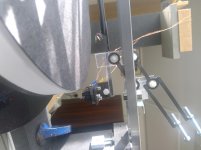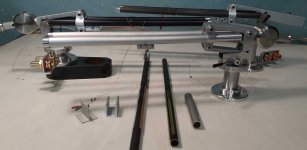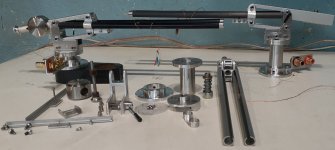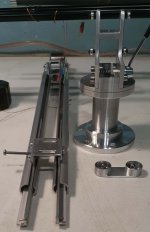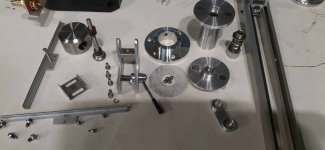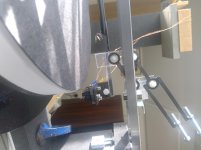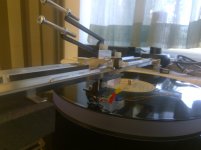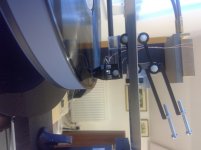Hi. This thread is amazing, great looking tonearms.
I remember linear tonearms were the thing in the early 1980s and many well known brands were offering them on their mini hi fi systems. Not sure why they went out of style.
I was wondering if anyone has seen this video, is it accurate, and maybe it will be of use for anyone designing a tone arm of any sort.
Electron microscope slow-motion video of vinyl LP - YouTube
Apparently the needle zig zags from side to side, as well as maybe moves up and down, I don't know yet. How is all that sound stored in a little series of valleys and mountains is beyond me.
I remember linear tonearms were the thing in the early 1980s and many well known brands were offering them on their mini hi fi systems. Not sure why they went out of style.
I was wondering if anyone has seen this video, is it accurate, and maybe it will be of use for anyone designing a tone arm of any sort.
Electron microscope slow-motion video of vinyl LP - YouTube
Apparently the needle zig zags from side to side, as well as maybe moves up and down, I don't know yet. How is all that sound stored in a little series of valleys and mountains is beyond me.
Last edited:
I made two light and one heavy version of Lil Casey. The photos are attached.
Best regards,
Eduard View attachment 879560
View attachment 879561
View attachment 879562
View attachment 879563
Amazing work Eduard, i hope they play as well as they look?
Are you still using one of them.
Interesting how simple and primitive mine looks in comparison, but to me, making it with saws, hand drill files sandpaper etc was part of the fun!
mike
Congratulations Eduard, again magnificent realizations, I would say more accurate than mine. After all, by now you have built more LCs than me...
Some curiosities - the sections used and the dimensions of the CW suggest that the weight of the double rail + double carriage is quite considerable: have you observed problems with the vertical articulation? By halving the weight of the eff. moving masses of the LC MK1, in the carbon MK2 version (26 gr cartridge included) - I got a noticeable improvement, on warps.
Another question. what kind of bearings did you use for the parallelogram?
carlo
I don't know if you've seen my latest version, the Lil Casey-Prism (#3840 parts - #3899 realization #3988 measures + video): it too avoids any possible (while improbable) cart tilting, but with a single rail and an eff. mobile masses of about 30-32 gr. A carbon version could be even a few grams lighter
Now in use since months: comfortable and good sounding, for my taste.
Some curiosities - the sections used and the dimensions of the CW suggest that the weight of the double rail + double carriage is quite considerable: have you observed problems with the vertical articulation? By halving the weight of the eff. moving masses of the LC MK1, in the carbon MK2 version (26 gr cartridge included) - I got a noticeable improvement, on warps.
Another question. what kind of bearings did you use for the parallelogram?
carlo
I don't know if you've seen my latest version, the Lil Casey-Prism (#3840 parts - #3899 realization #3988 measures + video): it too avoids any possible (while improbable) cart tilting, but with a single rail and an eff. mobile masses of about 30-32 gr. A carbon version could be even a few grams lighter
Now in use since months: comfortable and good sounding, for my taste.
Last edited:
Good morning Folks on this thread,
I am hoping for some feedback, analysis and advice please.
Having become interested and read a lot and following advice from several of you i have reached a stage where i have a working radial rail prototype arm, it sounds good to me, it’s not pretty because i spend what time i have on making it work rather than elegant build.
I work essentially with hand tools so it has to be simple and economical to construct and have tolerance to cope with inconsistent construction which i feel also gives tolerance in operation.
The radial rails are V on V 5mm Delrin balls with a 30mm spacer between the runner areas. There is a primary rail with the carriage etc fixed in relation to the runner rail and a secondary runner and rail to provide stability which is articulated from the fixed part in all axes to accommodate irregularities
Under and between this is the parallelogram to accommodate vertical cartridge movement to accommodate warp with the cartridge mount extended under the fixed parallelogram leg. Its built with Ball bearings at the moment but i might do a Mylar hinge variant as well. It can be miniaturised for weight as well. The pictures attached show it playing a record and idle to show the mechanism extended.
I would like some input, analysis and advice please on a few things;
1. Does the geometry and mechanism for warp accommodation eliminate horizontal torque on the carriage completely or as well as possible, it works better than before when the cartridge extended along the length of the parallelogram so i would like to know if those more knowledgeable feel its now optimised in that respect.
2. What next might improve things further?
Many thanks
Mike
I am hoping for some feedback, analysis and advice please.
Having become interested and read a lot and following advice from several of you i have reached a stage where i have a working radial rail prototype arm, it sounds good to me, it’s not pretty because i spend what time i have on making it work rather than elegant build.
I work essentially with hand tools so it has to be simple and economical to construct and have tolerance to cope with inconsistent construction which i feel also gives tolerance in operation.
The radial rails are V on V 5mm Delrin balls with a 30mm spacer between the runner areas. There is a primary rail with the carriage etc fixed in relation to the runner rail and a secondary runner and rail to provide stability which is articulated from the fixed part in all axes to accommodate irregularities
Under and between this is the parallelogram to accommodate vertical cartridge movement to accommodate warp with the cartridge mount extended under the fixed parallelogram leg. Its built with Ball bearings at the moment but i might do a Mylar hinge variant as well. It can be miniaturised for weight as well. The pictures attached show it playing a record and idle to show the mechanism extended.
I would like some input, analysis and advice please on a few things;
1. Does the geometry and mechanism for warp accommodation eliminate horizontal torque on the carriage completely or as well as possible, it works better than before when the cartridge extended along the length of the parallelogram so i would like to know if those more knowledgeable feel its now optimised in that respect.
2. What next might improve things further?
Many thanks
Mike
Attachments
Hi Mike
I am not one that can answer those questions, but I really think the achievements here, making for the first time a truly tangential tracker, deserves all the expert wisdom to further refine the basic concept.
To think, that this has been developed in a DIY audio forum, with the great pioneering work from Carlo and the persistent work from Mike to make a working example of a arm where the parallelogram is moved out to the cartridge (and, in Mike´s case, only with the use of handtools), and not in a sophisticated laboratorium in one of the commercial manufactors of audio, is amazing.
Great job, Gentlemen!

I am not one that can answer those questions, but I really think the achievements here, making for the first time a truly tangential tracker, deserves all the expert wisdom to further refine the basic concept.
To think, that this has been developed in a DIY audio forum, with the great pioneering work from Carlo and the persistent work from Mike to make a working example of a arm where the parallelogram is moved out to the cartridge (and, in Mike´s case, only with the use of handtools), and not in a sophisticated laboratorium in one of the commercial manufactors of audio, is amazing.
Great job, Gentlemen!

I'm using steel 6x2x2,2mm bearings, cleaned of oil by kerosene, and breakin-in using electric motor
before installing. All three tonearms are working very well in vertical plane, not depending of difference in
vertical masses.
For tubes I'm using crossbow arrow shafts, made of both duralumiium and carbon, they are light and well
made. For heavy tonearm (used with low compliance cartridges and substancial tracking weight) goes
regular aluminum tube from DIY-ers store.
First picture shows metal profiles, used for tonearm.
For the purpose of using larger balls, slots are somewhat turned, and r-shape inserts are used, rear one
installed on hinge.
While using two tubes it is easier to get stability and minimal play.
All three versions are working well, both mechanically and sonically. Owners really enjoy them all.
Lil Casey is very compact, user friendly, and allowing installation on almost any turntable.
before installing. All three tonearms are working very well in vertical plane, not depending of difference in
vertical masses.
For tubes I'm using crossbow arrow shafts, made of both duralumiium and carbon, they are light and well
made. For heavy tonearm (used with low compliance cartridges and substancial tracking weight) goes
regular aluminum tube from DIY-ers store.
First picture shows metal profiles, used for tonearm.
For the purpose of using larger balls, slots are somewhat turned, and r-shape inserts are used, rear one
installed on hinge.
While using two tubes it is easier to get stability and minimal play.
All three versions are working well, both mechanically and sonically. Owners really enjoy them all.
Lil Casey is very compact, user friendly, and allowing installation on almost any turntable.
Hi Mike,
You have done an excellent job designing and building the arm.
My input would be to measure the arm.
1. Check VTF at 3 stylus heights and 4 positions across the LP. What you're looking for is consistent VTF as the stylus raises and lowers across the LP
2. Spectrum analysis of a sweep to see if there are any artifacts and where they are in the frequency band. This will highlight resonance behavior.
Also maybe try G3 or5 ceramic balls.
You have done an excellent job designing and building the arm.
My input would be to measure the arm.
1. Check VTF at 3 stylus heights and 4 positions across the LP. What you're looking for is consistent VTF as the stylus raises and lowers across the LP
2. Spectrum analysis of a sweep to see if there are any artifacts and where they are in the frequency band. This will highlight resonance behavior.
Also maybe try G3 or5 ceramic balls.
Many thanks for the response and kind words Warren, i know i am way behind most of you, but it is great fun and i greatly appreciate the input and support, i think my Ortofon balance is inadequate for that, might have to buy a digital......My input would be to measure the arm.
1. Check VTF at 3 stylus heights and 4 positions across the LP. What you're looking for is consistent VTF as the stylus raises and lowers across the LP
2. Spectrum analysis of a sweep to see if there are any artifacts and where they are in the frequency band. This will highlight resonance behavior.
I shall have to do some research on how to do this, any good pointers for a simple starter route please,
i shall take a look also, many thanks your thoughts, mikeAlso maybe try G3 or5 ceramic balls.
Hi Mike,
This is a long thread but have a read through the first few pages.
Howto - Distortion Measurements with REW
I use a Focusrite Solo with REW as an audio spectrum analyser. Virtins Technology tested the Solo and it performed extremely well. I was going to buy an Agilent Dynamic Signal Analyser until I stumbled on this. It's cheap and it works especially well for comparison measurements (before and after). I have never tested its absolute accuracy.
It would be worth investing in a digital scale. I found with my LTA VTF was varying with stylus height and the carriage was not stable as it rode a warp (which almost all LP's have). After some measurements of VTF at different heights I lowered the COM of the carriage which made a significant improvement in sound, mostly fine detail.
Before and after measurements showed reduced sidebands in a 1kHz fundamental tone, this proved carriage stability was causing frequency modulation of the signal.
This is a long thread but have a read through the first few pages.
Howto - Distortion Measurements with REW
I use a Focusrite Solo with REW as an audio spectrum analyser. Virtins Technology tested the Solo and it performed extremely well. I was going to buy an Agilent Dynamic Signal Analyser until I stumbled on this. It's cheap and it works especially well for comparison measurements (before and after). I have never tested its absolute accuracy.
It would be worth investing in a digital scale. I found with my LTA VTF was varying with stylus height and the carriage was not stable as it rode a warp (which almost all LP's have). After some measurements of VTF at different heights I lowered the COM of the carriage which made a significant improvement in sound, mostly fine detail.
Before and after measurements showed reduced sidebands in a 1kHz fundamental tone, this proved carriage stability was causing frequency modulation of the signal.
Thanks Again Warren, i read the thread but it seemed to be about assessing amps?
So i imagine that you play a record through the whole system and the microphone picks it up and its analysed in REW.
I have a UMIK1 for my speaker set up with REW.
What does the Solo do in this loop please, maybe you could very kindly do a dumbed down version for me, stage by stage?
maybe i haven't read enough?
many thanks
Mike
So i imagine that you play a record through the whole system and the microphone picks it up and its analysed in REW.
I have a UMIK1 for my speaker set up with REW.
What does the Solo do in this loop please, maybe you could very kindly do a dumbed down version for me, stage by stage?
maybe i haven't read enough?
many thanks
Mike
Hi Mike,
It would be worth investing in a digital scale. I found with my LTA VTF was varying with stylus height and the carriage was not stable as it rode a warp (which almost all LP's have). After some measurements of VTF at different heights I lowered the COM of the carriage which made a significant improvement in sound, mostly fine detail.
Before and after measurements showed reduced sidebands in a 1kHz fundamental tone, this proved carriage stability was causing frequency modulation of the signal.
So, i am currently aiming to get the stylus as near rail height as possible for my next modification, which inevitably raises COM.........this might be the wrong direction? - i also believe the Mylar hinged parallelogram sounds better in detail, cymbals, snare etc than the BB (larger) one but i know its flawed in VTF variation, but this is probably outside the range of warp, +/_ 1-2mm? its difficult stage by stage but just now i played something I've not played for a while and i thought it had improved the reproduction (detail, separation, impact etc) noticeably since last time! this was Fleetwood Mac off Rumours, the chain, which has a big dynamic and frequency range, much more than on line versions.
Hi Eduard
Thanks for the clarification on your Lil Casey - interesting developments
The idea of bearing break-in is very useful - I had used 5x2 bearings on the first one, but maybe they weren't good enough; using pentips on the Carbon and Prism versions improved both friction and sound, but complicated their construction
Again on the first LC, not finding arrows of diameter > 10, I had turned an Ergal tube down to 0,4 mm; but then, once cutted the groove, it resonated horribly - the material of the arrows is much better even than the Avional.
Also interesting is the retraction of the parallelogram attachment to the base, which allows the carriage to be extended by a couple of cm.
I don't like the double rail, but to do without it with the Prism version took me certainly a bigger constructive commitment.
carlo
I'm glad if the Lil Casey is being replicated and developed by diyers and skilled craftsmen like you: it is comfortable to use and sounds really right.
I hope instead that in the future some manufacturer will not sell previous achievements as its own invention, as has happened too many times in the past - I will spare you the names, since we all know them.
Thanks for the clarification on your Lil Casey - interesting developments
The idea of bearing break-in is very useful - I had used 5x2 bearings on the first one, but maybe they weren't good enough; using pentips on the Carbon and Prism versions improved both friction and sound, but complicated their construction
Again on the first LC, not finding arrows of diameter > 10, I had turned an Ergal tube down to 0,4 mm; but then, once cutted the groove, it resonated horribly - the material of the arrows is much better even than the Avional.
Also interesting is the retraction of the parallelogram attachment to the base, which allows the carriage to be extended by a couple of cm.
I don't like the double rail, but to do without it with the Prism version took me certainly a bigger constructive commitment.
carlo
I'm glad if the Lil Casey is being replicated and developed by diyers and skilled craftsmen like you: it is comfortable to use and sounds really right.
I hope instead that in the future some manufacturer will not sell previous achievements as its own invention, as has happened too many times in the past - I will spare you the names, since we all know them.
No speaker and microphone for the measurement. Feed the signal from the preamp output to the Solo.
Thanks Grufti, reality has struck home, this is another massive area in which i have little understanding, knowledge or competence.
I had not thought about measuring before now, just get it tracking properly, following others ideas and principles and sounding OK.
I understand the principle it should measure ok but no more!
Although i use REW to set up my speakers, i have no idea what to do in measuring the arms performance, is there anything that gives a gentle intro that you know of please?
Basic examples are, what is the signal the arm is trying to read, music or something else, what are the criteria one measures, the thread Warrjon kindly sent takes me straight in out my depth...........if i learn the first bits i can return to that later. having said that, a year ago i thought the same about REW on the speakers.......
mike
Thanks Again Warren, i read the thread but it seemed to be about assessing amps?
So i imagine that you play a record through the whole system and the microphone picks it up and its analysed in REW.
I have a UMIK1 for my speaker set up with REW.
What does the Solo do in this loop please, maybe you could very kindly do a dumbed down version for me, stage by stage?
maybe i haven't read enough?
many thanks
Mike
The Solo is a high quality USB sound card. It's FR and noise floor are far superior to any inbuilt sound card.
The Solo is the input device. You do not use the microphone, feed the output of the phono pre directly to the line input of the Solo. Open REW RTA. Then it's a matter of setting up various parameters in RTA to do the measurements.
If you decide to go down this route I would be happy to guide you through the process.
Hi All,Hi Mike,
It would be worth investing in a digital scale. I found with my LTA VTF was varying with stylus height and the carriage was not stable as it rode a warp (which almost all LP's have). After some measurements of VTF at different heights I lowered the COM of the carriage which made a significant improvement in sound, mostly fine detail.
Neoteck digital stylus balance for £10 is just about within the budget! - do i need to know anything about stylus balances or is this ok? - one thought, is it shallow enough to go under the stylus now i have restricted warp movement of 5mm?
Mike
I am in
Please do
And as a side question, would spending the money on the Virtins software package give one opportunities to measure more turntable related things than REW ?
tia,
dennis h
If you decide to go down this route I would be happy to guide you through the process.
Please do
And as a side question, would spending the money on the Virtins software package give one opportunities to measure more turntable related things than REW ?
tia,
dennis h
If you decide to go down this route I would be happy to guide you through the process.
Many thanks Warren, i do want to improve the beast! so probably need an objective measurement but, - i need to mull over the rationale, at the moment my entire arm set up has a material cost of <£50 so spending £100 to measure it might be very good value for a measuring set up but its expensive in my project terms. I sort of know the answer but need to reset priorities, its not the cash, its the philosophy! (- yes i know the rest of the audio chain cost much more etc etc.)
I am sure i am likely to be taking up your kind offer on guidance and will be interested to see other input as well. Will i then need other measurements or would this suffice at my level?
Rachmaninov 2 sounding nice just now.
mike
- Home
- Source & Line
- Analogue Source
- DIY linear tonearm
